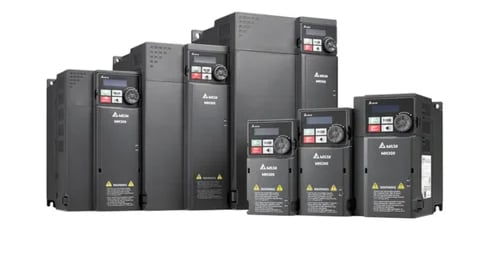Understanding VFD and Its Purposes
Learn what a Variable Frequency Drive (VFD) is, how it controls motor speed, and its role in energy saving and process optimization.


What is a VFD? (VFD क्या है?)
A Variable Frequency Drive (VFD) is an electronic device designed to control the speed and torque of electric motors. It achieves this by varying the frequency and voltage of the electrical power supplied to the motor. VFDs are widely used in industrial, commercial, and residential applications to improve energy efficiency, enhance process control, and extend the life of mechanical equipment.
Hindi- VFD एक ऐसा electronic उपकरण है जो electric motor की speed और torque को नियंत्रित करता है। यह motor को मिलने वाली frequency और voltage को बदलकर काम करता है। इसका उपयोग उद्योगों, व्यवसायों और घरों में energy efficiency बढ़ाने, process को बेहतर बनाने और उपकरणों की उम्र बढ़ाने के लिए किया जाता है।
⚙️ How Does a VFD Work? (VFD कैसे काम करता है?)
Electric motors typically operate at a constant speed determined by the frequency of the electrical supply. In India, this frequency is usually 50 Hz. A VFD changes this frequency and voltage, allowing the motor to run at different speeds depending on the load requirement.
Hindi- भारत में motors आमतौर पर 50 Hz की frequency पर चलते हैं। VFD इस frequency और voltage को बदलता है जिससे motor को जरूरत के अनुसार अलग-अलग speed पर चलाया जा सकता है।
The working of a VFD involves three main stages:
First, it converts the incoming AC power to DC using a rectifier.
Then, it smooths and stores this DC power in a DC bus.
Finally, it converts the DC back into AC with variable frequency using an inverter.
Hindi- VFD तीन चरणों में काम करता है: पहले AC को DC में बदलता है, फिर उसे smooth करके store करता है और अंत में उसे inverter के माध्यम से वापस variable frequency AC में बदल देता है।
🎯 Key Purposes of VFDs (VFD के मुख्य उद्देश्य):
Energy Efficiency (ऊर्जा दक्षता): One of the most important benefits of using a VFD is energy savings. By adjusting the motor speed to match the actual load, VFDs help reduce unnecessary power consumption. This is particularly useful in systems like HVAC, water pumps, and industrial fans.
Even a small reduction in motor speed can lead to significant energy savings. For example, reducing the speed by 20% can result in nearly 50% energy savings in fan and pump systems due to the cube law of power consumption.
Hindi - VFD motor की speed को actual load के अनुसार adjust करता है जिससे energy की बचत होती है। यह HVAC systems, pumps और fans जैसे applications में बहुत उपयोगी होता है।
Process Control (प्रक्रिया नियंत्रण): VFDs allow precise control over motor speed, which is essential for maintaining consistency in industrial processes. This leads to better product quality, reduced waste, and improved system responsiveness. Industries such as textile, food processing, and chemical manufacturing benefit greatly from this level of control.
Hindi- Motor की speed पर precise control होने से process का regulation बेहतर होता है जिससे product की quality बढ़ती है, waste कम होता है और system की responsiveness बेहतर होती है।
Reduced Mechanical Stress (कम यांत्रिक तनाव): Traditional motors start and stop abruptly, which can cause mechanical stress on components like gears, belts, and bearings. VFDs enable soft starting and stopping, reducing wear and tear. This not only extends the life of the equipment but also reduces the frequency and cost of maintenance.
Hindi- VFD motor को धीरे-धीरे start और stop करता है जिससे mechanical parts पर कम stress पड़ता है और उनकी life बढ़ती है।
Cost Savings (लागत में बचत): Using VFDs leads to multiple cost-saving opportunities. Lower energy bills, reduced maintenance costs, and improved system efficiency all contribute to significant operational savings. In large facilities, the return on investment (ROI) from installing VFDs can be achieved within a few months due to the cumulative savings.
Hindi- Energy bills कम होने, maintenance में कमी और system efficiency बढ़ने से overall खर्चा कम होता है।
Protection Features (सुरक्षा विशेषताएं): Modern VFDs come equipped with several protection features that ensure safe motor operation. These include:
Overload protection
Short circuit protection
Voltage fluctuation protection
Phase loss detection
These features are especially important in critical applications where motor failure can lead to costly downtime or safety hazards.
Hindi- VFD में overload, short circuit, voltage fluctuation जैसी समस्याओं से बचाव के लिए protection features होते हैं जिससे motor की सुरक्षा बनी रहती है।
🏭 Applications of VFDs (VFD के उपयोग):
VFDs are used in a wide range of industries and systems. Some common applications include:
HVAC Systems – For controlling fans, compressors, and pumps to maintain temperature and airflow efficiently.
Water Treatment Plants – To regulate pump speeds and flow rates, ensuring optimal water processing.
Manufacturing Units – For conveyor belts, mixers, and machine tools where speed control is essential.
Agriculture – In irrigation systems and grain handling equipment to optimize performance and reduce energy use.
Renewable Energy Systems – In wind turbines and solar tracking systems to adjust speed and direction based on environmental conditions.
Hindi- VFD का उपयोग HVAC systems, water treatment plants, manufacturing units, agriculture और renewable energy systems में किया जाता है। यह सभी क्षेत्रों में efficiency और control को बेहतर बनाता है।
🔧 Choosing the Right VFD (सही VFD का चयन):
Selecting the right VFD depends on several factors:
Type and rating of the motor
Nature of the load (constant or variable torque)
Environmental conditions like temperature and humidity
Required control features such as PID control or feedback systems
Communication protocols like Modbus, Ethernet, etc.
